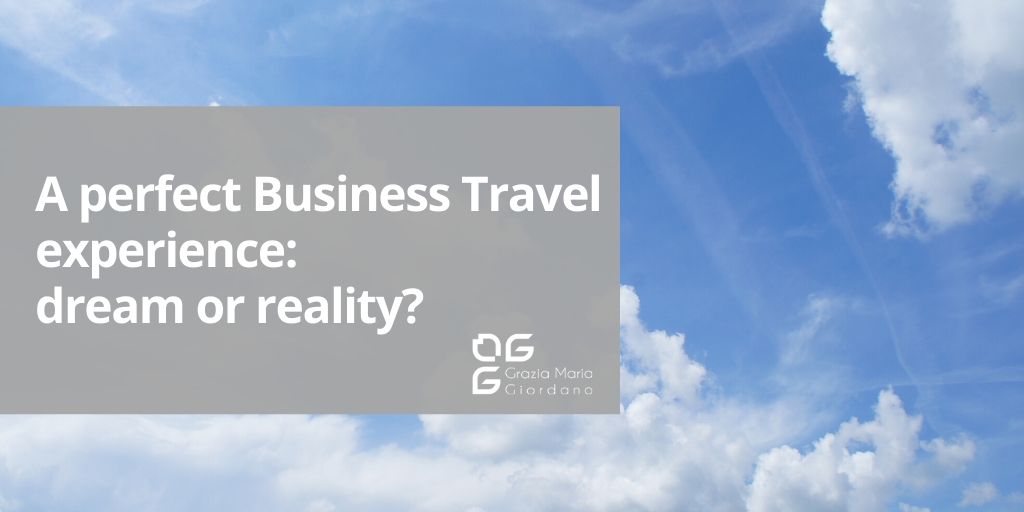Clara is a road-warrior: she usually travels more than ten days/month. She books her travel through the booking app provided by her company. Chooses the services needed for the trip and charges the costs to the credit card made available through the company financial provider. She knows very well what the policy is, but the app reminds her what the rules are and shows her only the options within the policy. The app also knows what her travel preferences are and highlights them each time she runs a search.
She’s pleased with her company travel policy and, in general, the way her company has organised the Business Travel Experience. It has been one of the factors she considered when accepting the company offer. Her company pays much attention to her needs and those of her colleagues. As frequent travellers, the policy grants them some benefits, and that makes their life much more manageable.
Also, the actual travelling is simple. All the documents she needs are in the app, and with her smartphone, she scans the receipts for the other expenses. Expense management is a piece of cake now!
In another room, Francesca, the company travel manager is looking at the most recent reports she got from the tools. Costs are under control. The CFO is also delighted with the results. They’re starting to prepare the new budget, and it’s nice to know they can create reliable estimates.
Francesca is also planning the next sourcing round: there are new projects on the horizon that have specific travel requirements.
Dream or reality?
In many companies, Business Travel doesn’t look like a dream. To the contrary, at times, it’s more a nightmare!
Whenever I tell people about my job as a consultant advising companies in the area of Business Travel, the reactions are all the same. They start telling their horror stories about how Business Travel (doesn’t) work(s) in their companies!
But even in the most challenging situations Business & Travel cannot do one without the other: it’s a kind of hate-love relationship, whose story is as old as that of the man.
The evolution of Business Travel
 Since the moment our early ancestors started growing crops and making the first utensils, they understood they had something valuable, which could be exchanged with products and other tools from other communities. The first merchants in the history of humanity set out then on their first trip.
Since the moment our early ancestors started growing crops and making the first utensils, they understood they had something valuable, which could be exchanged with products and other tools from other communities. The first merchants in the history of humanity set out then on their first trip.
In the middle ages, Marco Polo and other brave merchants travelled along the Silk Route to trade their goods and bring back precious loads of silk, spices and other unknown wonders to Europe.
It was at the side of the Silk Route that the first set of support systems to “business travellers” started developing. The “Caravanserai” made their appearance into the world providing accommodation, restaurants, and transportation (camels!).
Modern businesses are not any longer trading on the Silk Route, and their travellers are not sleepingin a “Caravanserai”, but the basics of the game have not changed that much.
Business and Travel industry have grown hand in hand: new technologies (rail, cars, planes, internet) have opened up new market opportunities, and companies are demanding more from their travel providers.
Businesses have expanded; companies have entered new markets, and they have tied critical strategic relationships with companies from other countries. They have clients in many countries, and their employees frequently travel to meet them. They want to be there for their clients when they need to.
And despite the developments in technology, which have made smarter solutions available, few people prefer a conference or a video call: the value of the personal relationship is considered irreplaceable.
And nowadays?
Research shows that roughly 28% of existing revenues could be lost without an in-person meeting and that the conversion rate from prospects to customers is about 40% with in-person meetings and quickly decrease to just 16% without in-person meetings.
And everybody agrees that a productive business trip can bring enormous advantage to the business.
Eliminating business travel could cost a company 17% of its profits, and it’d take approximately 3 years for profits to recover (Oxford Economics, September 2009). And more in general, Business Travel is found to generate a ROI of 10% (WTTC, Business Travel: a catalyst for economic performance). It means that for every dollar invested in Business Travel, on average companies get back incremental sales of 10 dollars. A whooping 10:1 yield ratio!
Business Travel has grown in importance and, in many situations, has become key in achieving strategic objectives. Nonetheless, it’s curious how many companies seem not to pay adequate attention and focus on developing the right framework which could support their Travellers and their Business in a more efficient, effective and satisfactory way.
For many companies, this has quickly made their Business Travel Programme (i.e. all the tools, processes and services which are set up to allow employees to manage a trip) obsolete and not fitting the new Business needs, leaving the Programme vulnerable to the many emerging challenges of the industry.
Today’s challenges in Business Travel
Business Travel is characterised by its many moving parts and, as a consequence, getting the whole picture is complicated and time-consuming.
The most pressing challenges are:
Fit for business: as business changes so should the Business Travel Programme. New projects, a company’s expansion in new markets might generate an increase in demand for Business Travel and could also cause a shift in the way Business Travel services need to be sourced. Think of a big project moving a group of people for a given period to an entirely new destination. This is a logistics nightmare, though very rarely the Travel Manager or any other person in charge of the organisation of Business Travel is timely involved when these new endeavours are planned. The consequence is easy to grasp: the Travel Programme won’t be fit for this new situation, resulting in inefficiency and frustrated travellers! The accelerated pace of change in nowadays business world makes the “fit for business” challenge more and more urgent
People: the modern Business Traveller seeks better work/life balance. She wants to use the same tools she uses for her travels and to choose from a more extensive selection of hotels and airlines. Flexibility is an essential element in the equation. Millennials (and not just them) look at their prospective employer travel policy before making a decision. The personal sacrifice of the business traveller is easily overlooked, and the level of people engagement can quickly drop a result of a (perceived) lousy travel policy. The travel policy is becoming a tool to attract and keep the best people.
Getting a hold of the real expenses: multiple booking channels, out of policy bookings, out-of-pocket travel expenses such as meals, taxis, local transportation, and costs through corporate cards can result in a maze of unreliable data.
Add to that, hidden costs sweeping through the overall organisation; they are dispersed across different budgets and departments such as the costs for the booking process, management processing, payments and treasury.
Processes: Manual and inefficient processes absorb a magnitude of resources and are mostly overlooked. Think about the time spent enquiring with the Travel Management Company and getting a ticket issued, or the time an employee spends in filling out an expense form.
As you may have concluded, in these conditions, it is nearly impossible to get clear visibility over travel costs. Timely, relevant, reporting is quite challenging to achieve and sometimes requires a significant human effort.
Employees’ security: The safety and security (so-called Duty of care) of employees who travel for business have become increasingly more critical for all companies. It is crucial that companies provide explicit guidelines for all travellers.
Are you ready for tomorrow?
The pace of change and globalisation has profoundly accelerated and spearheaded the effort of every organisation to stay competitive in the market and relevant for its clients.
Decisions need to be made quickly, leveraging on timely and thorough information and ensuring the whole organisation is aligned with the overall company objectives.
Business changes so fast that ensuring the Business Travel Experience fits the growing/changing needs of your business is critical.
What’s more, the internal complexity of organisations matches the external complexity of the Business Travel Industry where new technologies and tools develop and new trends emerge at incredible speed.
Keeping up with this complexity might prove very difficult, and costs keep increasing and the risk for the business along with them.
How do we get there?
The pillars of such a strategy are:
- Start with the Traveller (and all the stakeholders) in mind
Design a Business Travel Experience taking into consideration the travellers’ needs and pains. Involve the travellers and other stakeholders in the process of creating the organisation Travel Experience. It will render the policy more acceptable, and it will make it easier for them to comply with it.
- Align with the Company’s objectives
Design a Business Travel Experience in line with the business objectives and review it regularly. The organisation will always have the tools it needs to grow further and expand. Business Travel will provide the right leverage and won’t slow down the business. Let’s never forget that the Business Travel creates value for the Business and it’s a tool for the Business to use and not an end in itself!
- Ensure Leadership commitment
An explicit sponsorship of the travel program is the first step towards its success.
Active participation of top management will show that the program is a priority for the organisation and employees will be stimulated to adhere to the rules.
- Appoint the organisation’s Chief Business Travel Experience Officer
The Chief Travel Experience Officer will lead the design of the program, its implementation and will act as focal point in the organisation for the program itself, and will be responsible for promoting new actions for further optimising the Travel Program and monitoring the results over time.
- Use technology responsibly and don’t forget the processes
The industry is pushing out new technology at an incredible pace, but technology doesn’t work in a vacuum and helps only when the underlying processes work correctly. Look at the possibilities offered by booking tools and integration with payment platforms and ensure that the information is timely and accurate. This will form the basis for the company’s decisions!
- Choose the right partners
The Business Travel industry is quite complicated, and in some cases, there are no generally accepted standards. Negotiate then with the relevant suppliers, or choose one of the many platforms consolidating travel services: they are both safe routes to create the best-fit Business Travel Experience. The latter can bring substantial benefits and speed of implementation.
- Set a clear communication framework
Comprehensive and clear communication of the objectives of the travel program, together with appropriate education and training to those more directly involved in the organisation of business trips are an essential step towards a positive outcome.
The benefits of the People Friendly Business Travel Approach
- Get the best travel program for your organisation addressing the needs of the travellers and the company with consistent results over time
- Improve spending visibility and improve the allocation of resources
- Decrease in total spending
- Increase the productivity of your travellers, while keeping them safe and satisfied.
- The Dream
So if you feel that the Business Travel Experience in your company is a nightmare and you want to turn it into a dream, you now have the answer to your problem: think Traveller’s centric and adopt my People Friendly Business Travel approach






